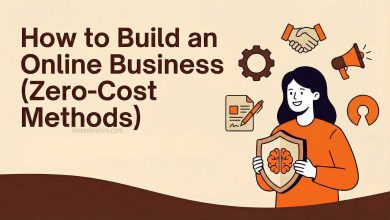What is SaaS Online Business Model : A Comprehensive Guide 2025
SaaS Online Business Model : The Software as a Service (SaaS) business model is a revolutionary approach to delivering software over the internet. Unlike traditional software that requires installation on a local computer, SaaS applications are cloud-based and accessible through web browsers. This model enables businesses to offer their services on a subscription basis, providing continuous value to customers while ensuring a steady revenue stream for the company.
Table of Contents
How the SaaS Business Model Works
At its core, the SaaS business model operates on the principle of delivering software to users via the cloud. Customers pay a monthly or annual subscription fee to access the software, which is managed, updated, and maintained by the provider.
Key Components of SaaS Model:
- Cloud Hosting: SaaS applications are hosted on remote servers, reducing the need for local storage.
- Subscription-Based Revenue: Customers pay a recurring fee to use the software, ensuring consistent cash flow for the business.
- Automatic Updates: Users receive the latest features and security updates without needing to install new versions manually.
- Scalability: SaaS platforms can easily scale based on demand, making them suitable for businesses of all sizes.
- Multi-Tenancy: A single version of the software serves multiple users, optimizing costs and efficiency.
Read more: 10 Common Online Business Mistakes to Avoid in 2025 : A Comprehensive Guide
Why SaaS is the Future of Online Business

The SaaS model has grown rapidly due to its cost-effectiveness, flexibility, and accessibility. It eliminates the traditional barriers of software distribution, allowing businesses to reach a global audience without physical installations. Some of the biggest names in tech, such as Google Drive, Zoom, Canva, and Shopify, have built their success using this model.
Advantages of the SaaS Model
- Lower Initial Costs – Users can access powerful tools without large upfront payments.
- Predictable Revenue Stream – Subscription-based pricing ensures consistent income.
- Global Accessibility – Customers can use the software from anywhere with an internet connection.
- Easy Maintenance & Updates – No need for users to manually install updates or patches.
- Security & Backup – SaaS providers handle data security and backups, reducing risks for users.
Types of SaaS Businesses
SaaS can be applied to various industries and niches. Some common types of SaaS businesses include:
1. B2B SaaS (Business-to-Business)
These platforms are designed for companies to streamline operations, improve efficiency, and enhance productivity.
- Examples: Salesforce (CRM), HubSpot (Marketing Automation), Slack (Communication)
2. B2C SaaS (Business-to-Consumer)
These SaaS applications are aimed at individual users for entertainment, productivity, or daily tasks.
- Examples: Spotify (Music Streaming), Netflix (Video Streaming), Canva (Graphic Design)
3. Horizontal SaaS
Software that serves multiple industries with a broad range of functionalities.
- Examples: Microsoft 365 (Office Tools), Zoom (Video Conferencing)
4. Vertical SaaS
Industry-specific software catering to a particular niche.
- Examples: Veeva Systems (Healthcare CRM), Procore (Construction Management)
How to Start a SaaS Business in 2025

If you’re looking to start a SaaS business, follow these essential steps:
Step 1: Identify a Market Need
Conduct market research to find pain points that can be solved with a software solution. Tools like Google Trends, competitor analysis, and customer surveys can help.
Step 2: Validate Your Idea
Before building your SaaS, validate the demand by creating a minimum viable product (MVP) or collecting feedback from potential users.
Step 3: Choose a Development Approach
- Custom Development: Hiring developers to build your software from scratch.
- No-Code/Low-Code Solutions: Platforms like Bubble or OutSystems allow you to create SaaS products with minimal coding.
Step 4: Implement a Subscription Model
Decide whether you’ll offer:
- Monthly/Yearly Subscriptions – Most common pricing model
- Freemium + Paid Upgrades – Free plan with premium features
- One-Time Payment – Less common in SaaS but used for lifetime deals
Step 5: Develop and Launch Your Product
Ensure your SaaS application is secure, scalable, and user-friendly. Before a full launch, conduct beta testing to gather feedback and fix issues.
Step 6: Market Your SaaS Business
Utilize digital marketing strategies such as:
- SEO & Content Marketing – Blogging, case studies, and guides
- Paid Advertising – Google Ads, FB Ads, LinkedIn Ads
- Email Marketing – Newsletters and personalized offers
- Affiliate & Referral Programs – Reward users for bringing in new customers
Step 7: Scale and Optimize
Analyze user behavior, improve features, and expand to global markets for long-term success.
Buy Now : Ecommerce Website With 100 Products
Challenges in Running a SaaS Business
While SaaS offers great potential, it comes with its own set of challenges:
- High Initial Development Costs – Building and maintaining a cloud-based software solution requires investment.
- Customer Retention – With a subscription model, keeping customers engaged is critical to avoid churn.
- Technical Issues & Security Concerns – Data breaches and downtime can damage reputation and revenue.
- Increasing Competition – The SaaS market is highly competitive, requiring continuous innovation.
Successful SaaS Business Ideas for 2025

- AI-Powered Chatbots – Automating customer service for businesses.
- Subscription-Based Crypto Trading Signals – Providing accurate crypto market insights.
- E-commerce Automation Tools – Helping businesses manage inventory, pricing, and marketing.
- Online Course Platforms – Creating and selling digital courses easily.
- SEO & Content Optimization Tools – AI-driven keyword research and content creation.
- Remote Work Management Software – Managing distributed teams effectively.
Conclusion
The SaaS business model is one of the most scalable and profitable online business models in 2025. With lower upfront costs, predictable revenue, and the ability to serve a global audience, SaaS has become a preferred choice for entrepreneurs. However, it requires careful planning, continuous product development, and strong marketing strategies to succeed. Businesses that focus on providing high-value solutions, improving customer experience, and staying ahead of industry trends can build a successful and sustainable SaaS company.
Disclaimer
The information provided in this article is for educational and informational purposes only. While every effort has been made to ensure accuracy, business success depends on various factors, including market conditions, execution, and competition. Readers are advised to conduct their own research and seek professional guidance before starting a SaaS business.
Keyword: SaaS Online Business Model – SaaS Online Business Model in 2025



